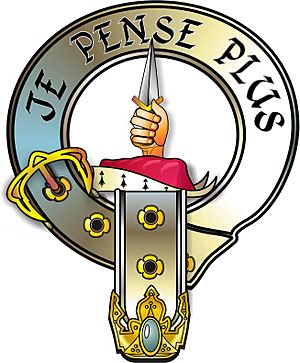Henry Erskine, 3rd Lord Cardross facts for kids
Henry Erskine, third Lord Cardross (1650 – 1693), was an important Scottish leader known as a covenanter. Covenanters were people in Scotland who supported a special agreement called the National Covenant. This agreement protected their right to practice their own form of Christianity, called Presbyterianism.
Contents
Who Was Henry Erskine?
Henry Erskine was the oldest son of David Erskine, 2nd Lord Cardross. His mother was Anne, the daughter of Sir Thomas Hope, 1st Baronet, who was a king's lawyer. The title of Lord Cardross was first given to the first Earl of Mar. He had the right to pass this title to any of his male family members. So, he gave it to his second son, Henry, along with the land known as the barony of Cardross.
Young Henry Erskine learned about the covenanter beliefs from his father. From an early age, he stood up against the government of Lauderdale. His wife, Catherine, strongly supported him in this. She was one of the two daughters of Sir William Stewart of Kirkhill.
Why Was Lord Cardross Imprisoned?
Henry Erskine faced many challenges because of his beliefs. His wife wanted a Presbyterian minister to lead worship in their home. This was against the rules at the time. Because of this, he was fined 4,000 pounds. He paid 1,000 pounds but could not get the rest of the fine removed.
On August 5, 1675, he was sent to prison in Edinburgh. He stayed there for four years. While he was in prison, meetings of covenanters were held near his home. Guards searched his house, broke into his chests, and were very rude to his wife. They even placed a guard on his home.
The government believed he was encouraging these covenanter meetings. This was a main reason why his fine was not reduced. On August 7, 1677, while still in prison, he was fined again. This time it was for half of his rent. This fine was because he allowed his two children to be baptized by ministers who were not officially approved.
Life After Prison
In 1679, the king's soldiers marched through his lands at Kirkhill and Uphall. They went out of their way to stay on his property. Henry Erskine was finally released from prison on July 30, 1679. He had to promise to pay his fine.
Early the next year, he traveled to London. He told the king about all the difficulties he had faced. However, the Scottish government was very upset by this. They sent a letter to the king, saying that Lord Cardross was not telling the truth. Because of this, he did not get any help or justice.
Moving to America and Returning to Scotland
After facing so many problems, Henry Erskine decided to move to North America. He started a farm at Charlestown Neck in South Carolina. But he was forced to leave his new home by the Spanish.
He then went to Holland. In 1688, he returned to England with Prince William of Orange. Prince William later became King William III.
Serving the King and Country
In 1689, Henry Erskine formed a group of soldiers called dragoons. He served under General Mackay in battles against Dundee. A new law was passed that gave him back his lands. He also became a special advisor to the king, known as a privy councilor. He was also put in charge of the mint, which made coins.
In July 1689, the Duke of Hamilton, who represented the king, accused Lord Cardross. He said that Cardross's soldiers had stopped a church minister from entering his church. But Cardross said he knew nothing about it.
Lord Cardross was part of the Battle of Killiecrankie. He wrote a letter to Lord Melville on July 30, describing the battle. Later, when the Duke of Hamilton suggested a new oath for the council, Cardross disagreed. He said it went against the government's rules. He also felt that swearing by the Bible in that way was not the Scottish or Presbyterian custom.
In December 1689, King William asked for three groups of dragoons to be formed. Lord Cardross was suggested to be the lieutenant-colonel and captain of the first group. In 1690, he was chosen to be part of a group that looked into the condition of universities. In October 1691, he went to London with the Earl of Crawford. They went to support the actions of the Scottish council against those who followed the Episcopal church.
Henry Erskine died in Edinburgh on May 21, 1693. He had four sons and three daughters. His oldest son, David Erskine, 4th Lord Cardross, later became the Earl of Buchan in 1695.
Family Connections
Henry Erskine's granddaughter, Katherine Erskine, married Gilbert Laurie of Polmont. Gilbert Laurie was the Lord Provost of Edinburgh (like a mayor) two times.
Images for kids



